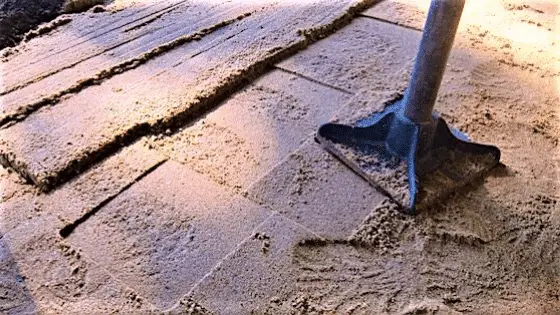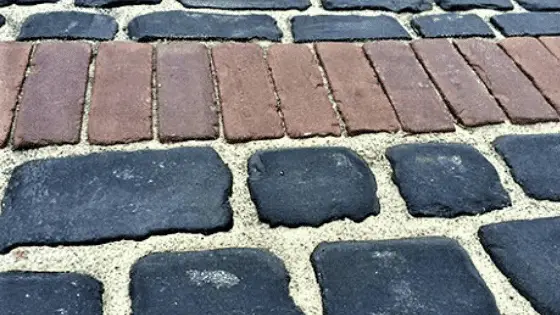Polymeric sand vs regular sand for pavers is undoubtedly a point of debate. However, it’s not hard by any means to solve the puzzle. Hi, in this article, I’m going to clear the air by discussing paving sands, their two major types (polymeric sand and regular sand) with their uses.
Finally, I will tell you which one is better and why. Without any further ado, let me start with defining paving sand.
Another must-read: Best Paver Sealers for a Wet Look
Polymeric Sand VS Regular Sand for Pavers
What is Paver Sand?

As the name suggests, paving sand is used when you do paving. It’s used for two purposes – bedding, and filling the joints between the blocks. You should not use the same type of sand for bedding and blocking the paver stones. It’s because different paving sands have their characteristics to serve a particular purpose better than others.
When it’s about sand bedding, regular sand or concrete sand or washed river sand are the ones you can go for. However, when it’s about filling the joints between the paver stones, you must choose polymeric sand. You must be wondering about these two types and eager to know their uses.
Hold on to your hat because I’m going to describe each of them with their uses in the next section.
Polymeric Sand Uses for Pavers

The name polymeric sand sounds a bit more sophisticated than what it is in reality. It’s a kind of sand that is responsible for providing an excellent bond between the pavers. Besides making the bond strong it gives so many other benefits, I will discuss them later in this article.
Regarding the formulation, polymeric sand is a kind of fine sand mixed with some other additives like Silica or polymer. When polymeric sand is exposed to water, it creates a powerful and durable bond between the paver stones. So, the core use of polymeric sand is to fill the joints between the patio pavers, lock them tight, and make them impassable.
That means polymeric sands are not for bedding but for filling the joints. You will find multiple brands selling polymeric sand, and sometimes it’s a bit overwhelming to find the best bet. To make your life easy, I’ve prepared a review guide on some of the best polymeric sands available on the market.
Related article: How to Use Polymeric Sand
Regular Sand Uses for Pavers

Unlike polymeric sand, you will want to use regular sand for bedding the paver stones. The concrete sand and sometimes the mason sand are used for bedding. These two types of sands are also used for filling the joints. However, as I said, polymeric sand outperforms all the other kinds of sands when it’s about locking the joints solidly.
First, you have to make a road base foundation. It’s some sort of crusher dust that is made up of both small and large particles to make a hard and stable base. Once you make a solid road base foundation, you have to apply the sand on that base for bedding. Here, you will want to apply the concrete sand. Alternatively, you can use washed river sand.
So, keep in mind, there is nothing like regular sand for paving. Either it should be concrete sand or washed river sand.
Polymeric Sand Vs Regular Sand – Which One is Better?
As I said earlier, although you can apply both these types of sands interchangeably, you should not do it that way. Polymeric sand should only be used for filling the joint, and regular sand or concrete sand should be used for bedding. This will give you the best performance.
Therefore, if you ask me which one is better? The answer is polymeric sand is better for locking the joints, and regular sand/concrete sand is better for bedding. Let’s discuss some of the benefits of using polymeric sand for making bonds between the paver stones. This will justify the reason behind choosing it for this purpose for sure.
Some benefits of polymeric sand over regular sand when it’s about filling the joint –
- Polymeric sand provides more durable and more reliable bonding than regular sand. The additives mixed with polymeric sand make it an incredibly strong agent to lock the pavers for a more extended period firmly. Regular sand fails to do so.
- Polymeric sands don’t wash away due to heavy rainfall. Whereas, regular sands tend to wash away quite quickly because of rains. As a result, the bond will last for long using polymeric sand compared to regular sand.
- One of the most significant benefits of using polymeric sand is it prevents the growth of weeds. Whether it stops weed growth completely or just prevents it, is a moot point. However, it’s quite evident that any regular sand welcomes the weed anywhere and anytime. At the same time, polymeric sand does the opposite. So, if you want to get rid of plucking weeds each summer, use polymeric sand instead of regular sand in filling the joint.
- Polymeric sand makes it hard and almost impossible for ants to get space and make their way between the pavers. On the other hand, regular sand doesn’t provide any blockage whatsoever for ants to get in between paver stones.
- You can choose from multiple colors and shades for polymeric sand. That means you have the liberty to match the color with the paver stone or anything you like to implement. Regular sand doesn’t provide this opportunity. It’s just that primary sand color. Nothing fancy.
As you can see, using polymeric sand for filling the joints will make no stone unturned to provide a durable bond between the pavers compared to regular sand. Therefore, polymeric sand is the winner to serve its purpose without any second thought.
Final Words
So, this is it. Polymeric sand vs regular sand for pavers should not be a moot point for you anymore. I thoroughly described both these two types of paving sands with their uses.
Who is the winner?
When it’s about filling the joint between pavers, polymeric sand is way better than regular sand by offering several benefits. But when it’s about sand bedding, concrete sand or washed river sand are the two best options for you.





